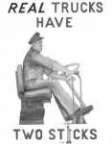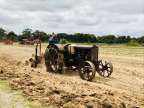Don't "water" tyres - Interesting
- HeyCharger
-
 Topic Author
Topic Author
- Offline
WHAT'S the worst way to ballast a tractor? By putting water in the tyres, farmers at a recent Case VIP Field Days in Tamworth were told. The seminar on ballasting, run by Case's tractor product manager, Phil Withell, was a revelation to those farmers and they are many who hold to the traditional wisdom that the first thing you do on buying a tractor is to fill its tyres with water. But Mr Withell told farmers at the seminar that this was a sure way to sap engine power and increase fuel consumption, because as the water continually tried to return to its level it exerted internal friction counter to the tyre's rotation. And because a tractor should carry "just enough" weight for the job, and ballasting requirements vary between applications, water-ballasted tractors are often too heavy for much of the working year. Side-effects of incorrect ballasting can include increased soil compaction and greater wear and tear on the machine. In a startling demonstration, Mr Withell showed a Case experiment in which identical tractors were loaded with 320 kilogram of weight over the rear axle one in the form of water ballast, another with cast weights. The two tractors were then run under identical conditions for 45 seconds, at the end of which the tractor carrying the cast weights was nearly a tractor length in front of the other. "The loading on the water-ballasted tractor amounted to only 80 litres in each dual tyre," Mr Withell said. "Most tractor tyres have a capacity of about 450 litres, and there are farmers who take the same attitude to putting water in tyres as they do with putting fuel into the tank they fill 'em up." There were other advantages to using cast weights, not the least being that "suitcase" type weights were easy to take on and off. This was important, Mr Withell said, because optimal ballasting was different depending on the application. Suitcase weights were also advantageous in that they exerted leverage over an axle. Suitcase weights fitted to the front increased load to the front axle, and reduced weight to the rear and visa versa but the overall weight remained unchanged. Mr Withell advised six steps towards achieving the correct relationship between the tractor and the ground: Use the table (below) to determine the total operating weight for your tractor. Use cast-wheel and\or suitcase weights to adjust the weight. Establish correct weight distribution according to the implement and tractor type. Using tyre manufacturer load and inflation tables, set the tyres to the correct minimum pressure. It is vitally important to set tyre pressures according to the weight they carry. Under normal operating conditions, measure wheel slip. This should be in line with the chart (below). If wheel slip is outside the guidelines, re-trace steps the first four steps listed here. Correct any power-hop. On MFD tractors, add two pounds per square inch to the front tyres and test again. If power-hop continues, add another two psi. Continue to add two psi, checking performance until the hop is eliminated. But never exceed the tyre maker's recommended maximum pressures. On four equal-wheel-drive tractors, add two psi to the rear tyres until the problem is eliminated. With duals or triples, all tyres on an axle should be set to the same minimum pressure.
Proud owner of;
1948 Massey Harris 44K.
1946 Ford Semi-Trailer Bus.
Please Log in to join the conversation.
As well, the weight balance got back to 60/40 rear to front, where it should be. The difference then was amazing, and fixed all of its bad habits, most importantly fuel use. And that tractor had bias ply tyres, which are less sensitive to water in tyres than today's radials.
Please Log in to join the conversation.
Please Log in to join the conversation.
- Posts: 6821
- Thank you received: 4715
Your better to die trying than live on your knees begging
Please Log in to join the conversation.
- MasseyHarris55
-

- Offline
- Ahhhhh thats what that does
- Posts: 323
- Thank you received: 31
Fixing things one big shifter at a time
Please Log in to join the conversation.
- Posts: 6821
- Thank you received: 4715
by sounds of what you are saying your over in the uk if so a lot differant than in oz the water sloshing around in tyres that causes the bounce goes if you throttle back and then gently pick up speed again on the road the water bounce wont happen in the paddock under normal work. remeber with a soil engaging implement no faster than 8 km/hr wears points realy quick .but that bounce of the water deffently goes if you know how to drive it out nice and gentle!Both my Massey Harris 55 and IH aos6 had water in the rear tyres ( I discovered this fixing a puncture on the 55 I got wet ) I soon drained the 55 it was undrivable at speed and shall soon drain the inter as it has the same problem best way I've found to get traction is to shut the throttle and let the tyres down but in saying that the older tractors minus linkage are designed to pull and it's what they do best ( 55 rescuing a very bogged 3000 series MF as an example) the other example I fondly remember is ploughing in open class 2 fourough against grey fergies that would spin and be constantly lifting the plough where as my old. Fordson N would plod on all day with a ronsomes 2 fourough trailed plough and a ratty pair of RAF straight bar rear tyres ( the tread pattern is just bars of rubber across the tyre ) without a problem old Harry would have been spinning in his grave just like his grey menaces
Your better to die trying than live on your knees begging
Please Log in to join the conversation.
- Posts: 6821
- Thank you received: 4715
I suppose I sound like a bit of a dill or somthing else. I was thinking after I typed my blerb if you have an ASO6 you proberly arnt in the uk :-[ :-[ :-[ :-[ :-[ the local tyre dealer once told me the main reason for tyre walls cracking is to lower air preasure . And if you have radial tyres you can't add water because they dont run tubes and apperntly because the inside of the tyre isn't smooth if you put a tube in it scuffs the tube but what do I knowby sounds of what you are saying your over in the uk if so a lot differant than in oz the water sloshing around in tyres that causes the bounce goes if you throttle back and then gently pick up speed again on the road the water bounce wont happen in the paddock under normal work. remeber with a soil engaging implement no faster than 8 km/hr wears points realy quick .but that bounce of the water deffently goes if you know how to drive it out nice and gentle!Both my Massey Harris 55 and IH aos6 had water in the rear tyres ( I discovered this fixing a puncture on the 55 I got wet ) I soon drained the 55 it was undrivable at speed and shall soon drain the inter as it has the same problem best way I've found to get traction is to shut the throttle and let the tyres down but in saying that the older tractors minus linkage are designed to pull and it's what they do best ( 55 rescuing a very bogged 3000 series MF as an example) the other example I fondly remember is ploughing in open class 2 fourough against grey fergies that would spin and be constantly lifting the plough where as my old. Fordson N would plod on all day with a ronsomes 2 fourough trailed plough and a ratty pair of RAF straight bar rear tyres ( the tread pattern is just bars of rubber across the tyre ) without a problem old Harry would have been spinning in his grave just like his grey menaces





Your better to die trying than live on your knees begging
Please Log in to join the conversation.
- MasseyHarris55
-

- Offline
- Ahhhhh thats what that does
- Posts: 323
- Thank you received: 31
Fixing things one big shifter at a time
Please Log in to join the conversation.